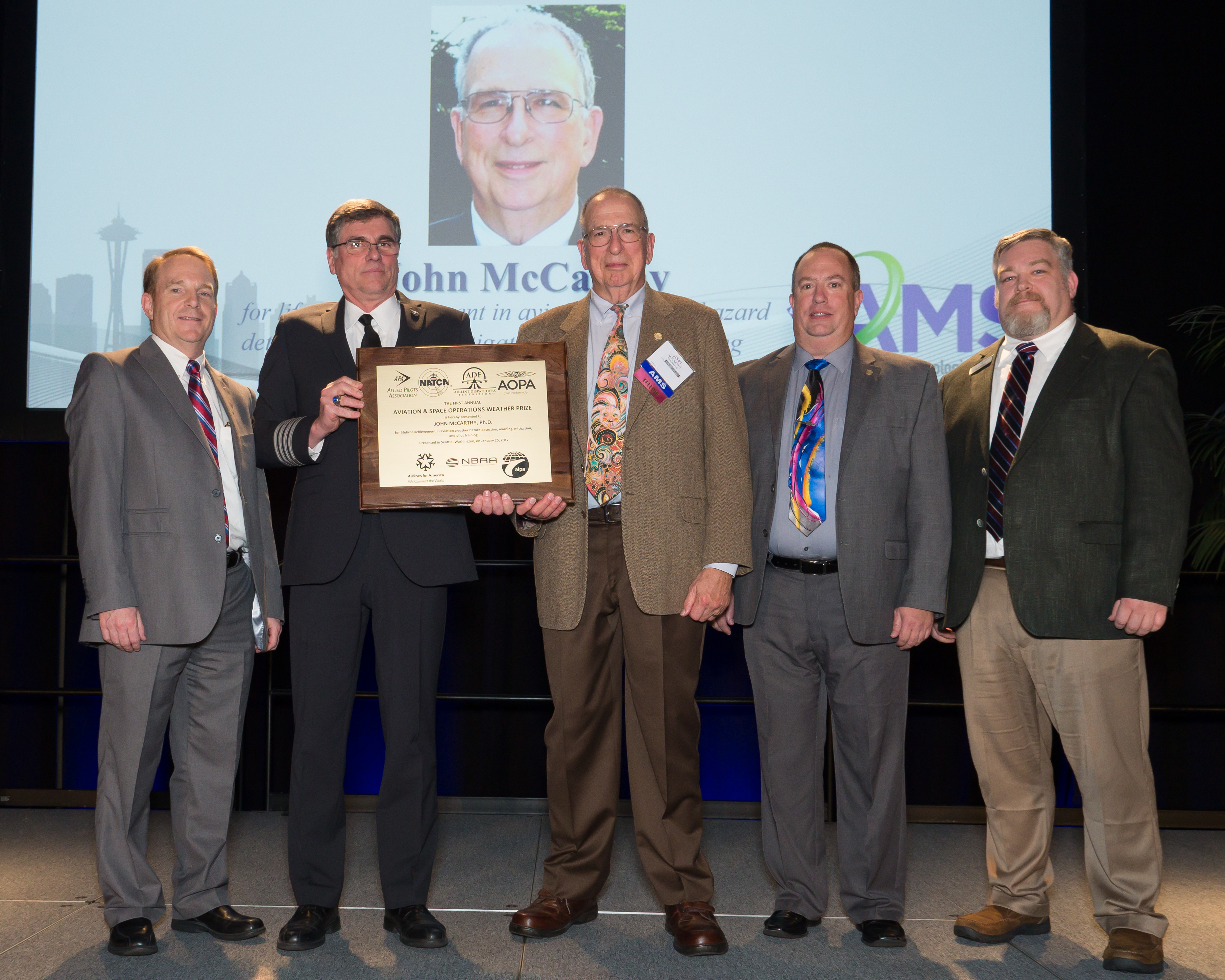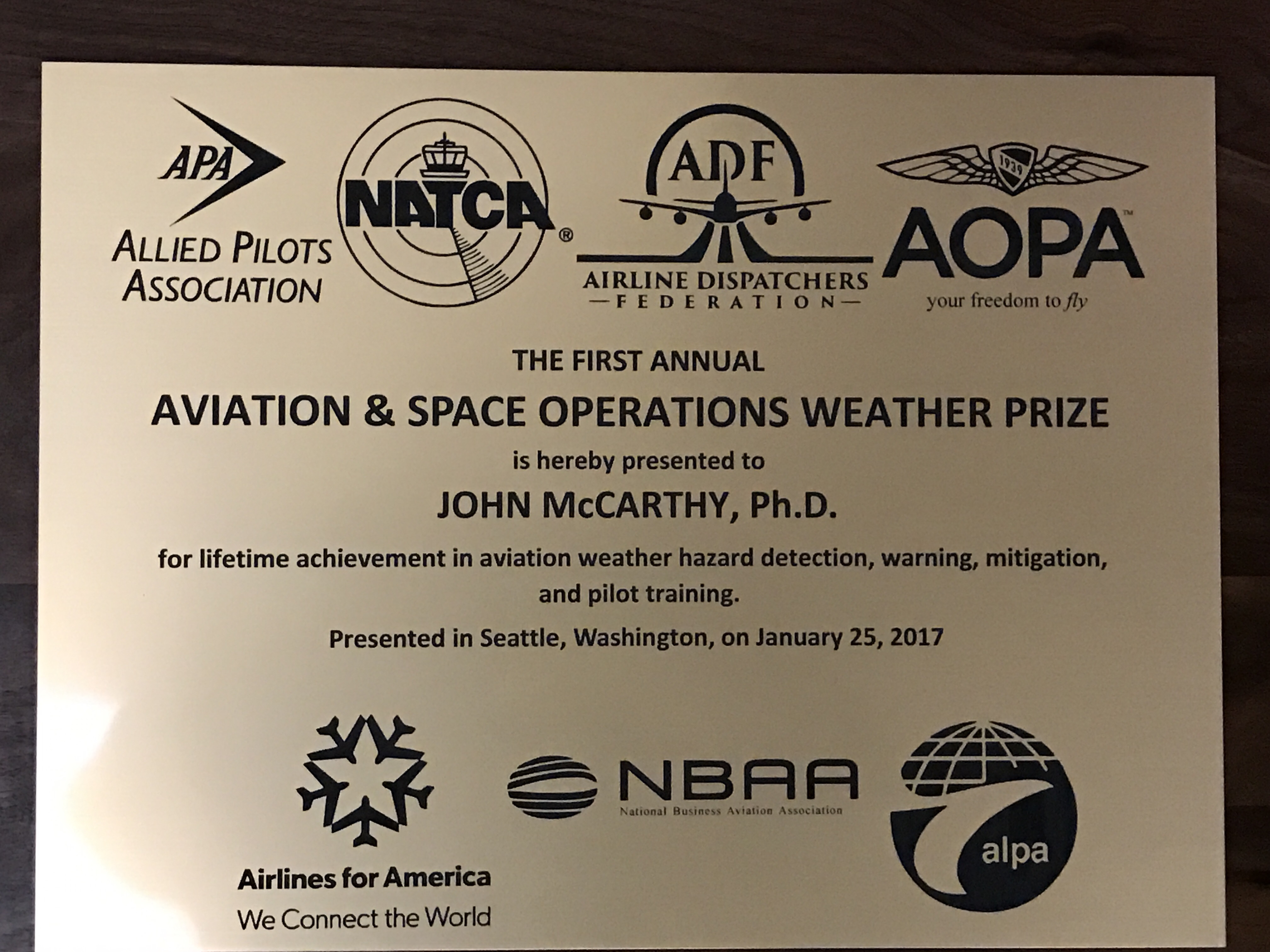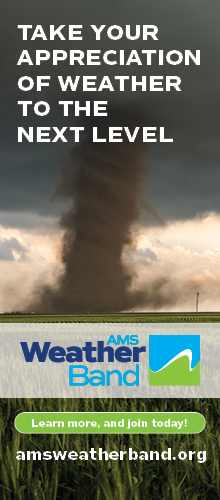by Captain Timothy H. Miner
Allied Pilots Association
Member: AMS Aviation, Range and Aerospace Committee
[Read the LOTRW “about” link and you’ll find an invitation to submit guest contributions. But the blog’s going-on-seven-year history has seen only a handful of takers. That’s a shame, because colloquy is better than soliloquy.
Tim Miner has just ended the most-recent drought. His guest post is welcome for other reasons. He connects the advance of meteorological science and science-based services to the resulting societal benefit. He highlights aviation’s interest in the work we do. Perhaps this example will inspire other user communities to form similar links with the AMS. Finally, he reminds us that like John McCarthy, we’re each individually positioned to make the world a better place. If you were at the 2017 AMS Annual Awards Banquet, you might recall the award presentation Tim describes. But you won’t have heard the inspiring backstory he relates here. WHH]
At a time when the work of meteorology and climatology is under scrutiny, it is important for the public to know about the critical successes of the science. Clearly, it will take all of us communicating these successes to change skeptical hearts. At the annual banquet of the AMS this past January, something unique happened. An entire industry stood up to say to the AMS, “Thank you for your science. It makes a difference. It saves lives.” In the century-old language of aviation we also said, “We have your six” which refers to the 6 o’clock position, or now more commonly referred to as “having your back.”
This past year seven aviation associations came together to create an annual award to honor the most significant work of AMS members to provide safety and economic efficiencies in our industry. We have named this award the “Aviation & Space Operations Weather Prize.” It has been an honor to lead this effort on behalf of the current chair of the AMS Aviation, Range and Aerospace Committee. But this was also very personal for me. You see, my life was saved directly by an AMS member, and that is the untold story
Let me first share my comments from the microphone just prior to dinner being served:
Fellow members of the AMS. This evening I have the privilege to speak on behalf of an industry as the representative of the Allied Pilots Association. This week during this conference we focused on observations and we have been observing you. With me tonight is Mr. Matt Tucker, National Air Traffic Controllers Association; Mr. John Kosak, National Business Aviation Association; and Mr. Mark Phaneuf, Air Line Pilots Association. Representatives for the Airlines for America; Airline Dispatchers Federation; and the Aircraft Owners and Pilots Association were unable to attend. We represent over a quarter of a million pilots, dispatchers and air traffic controllers; over 11,000 aviation businesses; over 40 commercial airlines and 1.5 trillion dollars of economic activity. This evening we are here to award the first of a new external honor to be given for the “most conspicuous effort to advance aviation and space operations safety or efficiency through the meteorological or climatological sciences.” We will give this honor annually to an individual or team affiliated with the AMS for a single act or a lifetime of achievement. The eighth voting member this year is the current chair of your Aviation, Range and Aerospace Committee, Dr. Cecilia Miner, whose vision to bring more user interface to the committee made all this happen. Members of the committee will be the sources for future nominations. Next year we will also be joined by the Range Commander’s Council.
While we will only give one award every year, in creating this program we are honoring all of you, the entire membership of the AMS for your scientific efforts. Our associations spell WEATHER beginning with the letters W and E. “WE” consider this society an equal partner in our industry.
Tonight, we present the first Aviation and Space Operations Weather Prize to Dr. John McCarthy. He was selected for his “lifetime achievements to identify, detect, warn, mitigate and promote industry education on the microburst hazard in commercial and private aviation.” Dr. McCarthy was the founding Director of the Research Applications Program at the National Center for Atmospheric Research, from 1981-1994 and the principal meteorologist associated with the development of the FAA Wind Shear Training Aid now used in commercial pilot training throughout the world.
Congratulations, Dr. McCarthy.

During the annual banquet of the American Meteorological Society on January 25, 2017, seven aviation associations came together to present the first “Aviation & Space Operations Weather Prize to John McCarthy for his work on researching the causes and mitigations to the microburst hazard in aviation. Present for the ceremony were: Mr. Mark Phaneuf representing the Air Line Pilots Association; Captain Timothy Miner representing the Allied Pilots Association and consortium lead; McCarthy; Mr. Matt Tucker, air traffic controller representing the National Air Traffic Controllers Association; and, Mr. John Kosak representing the National Business Aviation Association
With only minutes to introduce the concept of the award and make the presentation, that is all I could publicly say. However, during the dinner that followed I had the chance to share “my story” with John McCarthy and the rest of the representatives.
John McCarthy saved my life as a young pilot.
It was 1988 and I was a young Assistant Professor of Physical Geography/Climatology at the United States Air Force Academy, in Colorado Springs. As a military pilot I had already had one “close call” with weather when a lightning strike impacted my aircraft. I knew that the academy didn’t really teach weather courses, which seemed incredible for a school created to educate future aviators, so when it came time for graduate studies I chose as much weather as I could get before my assignment. While at the academy I was a young, vocal advocate for a meteorology major.
To get visibility for weather sciences I created a series of colloquium presentations. The first name recommended to me was John McCarthy from the National Center for Atmospheric Research (NCAR) just “up the road” in Boulder. He made a very good presentation on his work with the microburst hazard in aviation. It was filled with illustrations and pictures. It was very well done.
Ninety-days later that presentation saved my life. As an instructor pilot with one USAFA student in a small aircraft circumnavigating the Colorado Springs Airport, I saw the developing dust rings of a dry microburst ahead. Had it not been for John’s work I would not have known what I was looking at. Fortunately, his instruction gave me the time to coordinate other aircraft behind me to turn around and place several commercial airliners heading into the airport into holding. I turned around in time to “ride the edge of the wave.” Had I gone into the microburst I would not have survived in the aircraft I was flying.
That incident gave me the audience with the leadership of the school to make my case for a meteorology major. I’m convinced that this was an important bit of motivation they needed for change. By the time I left the faculty to pursue a dual career as a USAF reserve weather officer and a commercial airline pilot, USAFA was well on its way to having a program that thrives to this day. But regardless of the academic change, the most important thing to me is that the science, the research and the education that John McCarthy shared on that day saved my life. Very few meteorologists ever get to hear those words.
Ultimately, I am only one of many pilots and passengers on airplanes that have been saved by the work that John McCarthy led. His efforts are extensive and impressive. He was THE unanimous choice to be the first to receive the this prize. It is easy to see why.
John McCarthy was the founding Director of the Research Applications Program (RAP) at National Center for Atmospheric Research (NCAR), Boulder, CO, from 1981-1994. As Director of RAP, he directed research associated with aviation weather hazards including NCAR activities associated with National Science Foundation Joint Aviation Weather Studies (JAWS), which determined that microbursts were commonplace in the Denver area. A following FAA/RAP effort detected microbursts in real-time and transmitted warnings to pilots arriving and departing Denver with significant success. The success of this effort led the FAA to establish the Terminal Doppler Weather Radar (TDWR) Program, in close conjunction with MIT Lincoln Laboratory and RAP, which ultimately resulted in installing an automatic microburst detection and warning system for microbursts at 72 airports in the US. A major part of the RAP effort was focused on detection algorithm efforts, and determining the best way to fully transfer the hazard information to pilots. The RAP effort at NCAR focused on basic aviation weather research, and its critical transfer to improve operational safety to the airline industry. Aviation industry user groups were formed, which the developers and aviation users jointly worked together to carefully match detection results to user needs.
He was the principal meteorologist associated with the development of the FAA and Boeing-led and FAA-financed Wind Shear Training Aid now used in commercial pilot training throughout the world. McCarthy was a founding member of the FAA Research, Engineering, and Development Advisory Committee, and previously on the NASA Aviation Safety Program Executive Council.
The aviation and space operations associations coming together to recognize important contributions of science are very honored to fete this outstanding leader in aviation safety research. We will be back to the AMS every year to honor the important work taking place there.
Science really does matter. We’ve got your “six” now.

The plaque presented to John McCarthy contains the logos of the seven founding associations that came together to create the annual Aviation & Space Operations Weather Prize on January 25, 2017. They are from upper left and clockwise: The Allied Pilots Association, the National Air Traffic Controllers Association, the Airline Dispatchers Federation, the Aircraft Owners and Pilots Association, the Air Line Pilots Association, the National Business Aviation Association, and Airlines for America.
[Again, congratulations to John McCarthy, and thanks to Tim Miner. WHH]

